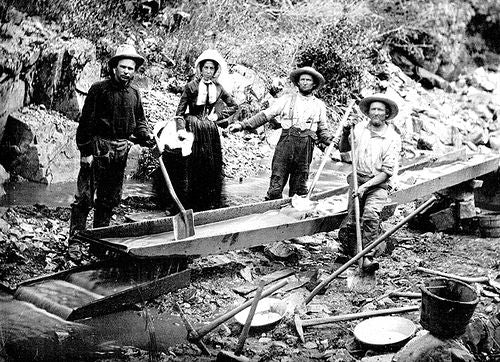Building America: the Gold Rush and Gold Rush Gold Bars.
A romantic aura hangs over the California Gold Rush of the 19th-century. The period saw hundreds of thousands of Americans and especially recent immigrants clamour to the West to strike gold. And in no time at all, a growing state and country was built on those gold rush gold bars.
Well, strike gold they did. Miners extracted more than 750,000 pounds of gold during the California Gold Rush.
So how did the Gold Rush and Gold Rush Gold Bars influence California? What about other states?
What impact did that momentous historical period have for the economic, cultural and environmental spheres in America?
Most concretely, the Gold Rush of 1850 ushered in 300,000 new arrivals to California by the mid 1850s.
To put that in perspective: One in every 90 people in the U.S. was living in California.
Other states were affected by this influx of gold seekers, since their populations decreased as more Americans travelled to California. It's been said the Gold Rush was the largest mass migration in U.S. history.
As you can see in the California ad, feverish excitement over the Gold Rush invited new industries to get rich. Industries from banking, to boating and shipping companies marketed themselves nonstop. They became an ideal transportation methods for bringing gold rush gold bars out of, and gold lovers into California.
Who knows how many entrepreneurs in these fields kept the business within their families generations, thanks to the Gold Rush's inspiration?
Gerald Nash makes some excellent points in A Golden State: Mining and Economic Development in Gold Rush California. He writes "In the language of economists, it served as a multiplier - an event that accelerated a chain of interrelated consequences, all of which accelerated economic growth.
Delivering Gold Rush Gold Bars created institutions still around today.
In both state and nation it spurred the creation of thousands of new businesses, banks, and financial institutions. Wells Fargo, for instance, was founded in 1852 to help deliver gold and underwrite paper against that gold. The Gold Rush stimulated rapid agricultural expansion, quickened the volume of trade and commerce, and created demands for new forms of transportation.
In great demand were hundreds of ancillary items associated with such mass migration to California, such as hardware, mining equipment, hydraulic operations. The Gold Rush also created a deep hunger for timber, and not just for housing. Mine shafts and tunnels were constructed from wood, and a decade post-Gold Rush that timber industry still boomed, thanks to rising interest in wagons and carriage makers.
So what came after Gold Rush gold bars?
Let's not forget how the wine industry began. Many of the new immigrants of the Gold-Rush generation laid the foundations for a successful wine industry. Miners may have preferred their whiskey, but quite a few also developed a taste for wine. As Nash wrote: "Agoston Haraszthy, an enterprising Hungarian immigrant, quickly grasped the potential opportunities. He planted dozens of varieties imported from Europe, as well as new strains.
Deservedly, he became known as the father of the California wine industry. Haraszthy "not only grew a variety of grapes, but built markets both in the state and around the world."
California's economy was stimulated unlike any other region in the United States. Moreover, due to the addition of so many varied communities, multiculturalism soon took root in California. Such diversity can still be seen today.
It would be remiss to neglect mentioning the negative effects of the California Gold Rush. Mother Earth took the brunt of the upsetting impact. Over time, water got poisoned with mercury, arsenic, cyanide, and other toxins, and forests were levelled for mining timbers.
Gold Rush historian Malcolm J. Rohrbough told National Geographic that throughout the 1860s and 1870s, a ferocious conflict developed between the mining and agricultural industries. "By the mid-1870s, the California government realized that agriculture was more lucrative than mining. They passed a series of laws that restricted the impact of mining on rivers."
The historian adds: "For example, they outlaw hydraulic mining. They severely restrict dredging.”
And most obviously, the Gold Rush stoked America's appetite for the glittery metal so many of us covet today. Who knows where we might be today if the Gold Rush in California never happened?

